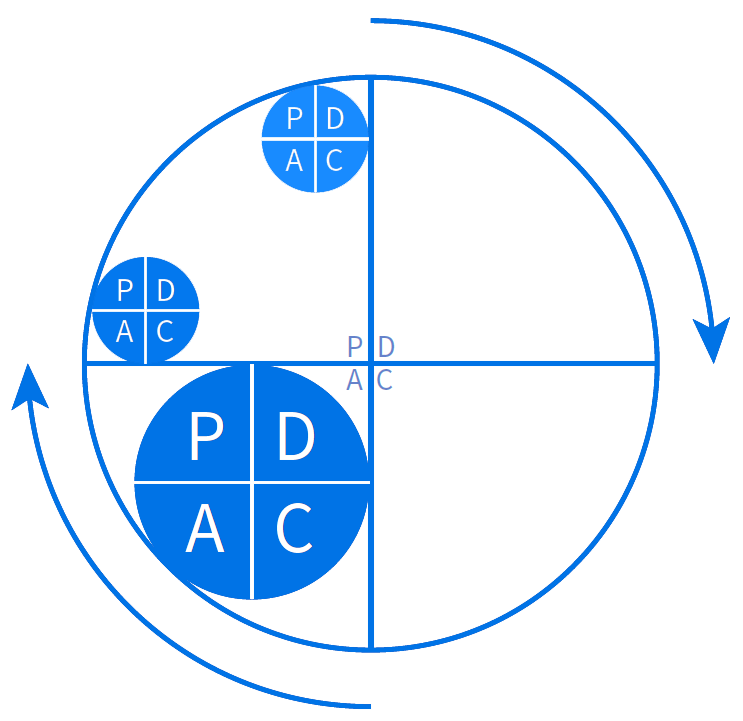PDCA is a continuous improvement tool, it stands for Plan-Do-Check-Act and is widely used for continuous improvement in various aspects like business and personal development.
This method originated in the 1920s, initially by the statistician Walter Armand Hughart in the model of the prototype PDS “Plan-Do-See”, then improved and popularized by his student Dr. W. Edwards Deming.
Now the PDS is replaced by PDCA, and people also call it Deming Cycle or the Deming Wheel.
Breakdown of the PDCA Cycle
Here’s a breakdown of each step:
Plan
The first step involves identifying a problem or an opportunity for improvement.
You then plan the changes or solutions needed to address the issue or capitalize on the opportunity.
Key actions involved in this phase:
- Gathering information
- Analyzing situation
- Defining objective
- Formulating plan
Do
Once you have your plan in place, you move on to the implementation stage.
Here, you actually carry out the plan by executing the processes and activities that you’ve defined.
This step is all about putting your plan into action and seeing how it works in practice.
Check
In this phase, you evaluate whether the changes had the desired effect.
Compare actual outcomes to the expected results from the “Plan” phase.
Key actions involved in this phase:
- Evaluating result
- Collecting data
- Analyzing reason (fail to achieve)
Act
Based on the results of the “Check” phase, take action. If the outcomes meet expectations, standardize the successful processes. If they don’t, adjust the plan and implementation methods for improvement. The focus is on learning and making incremental improvements over time.
You can also integrate the KISS model here, breaking down actions into Keep, Improve, Stop, and Start. PDCA is not a one-time process—after completing one cycle, the actions and insights inform the next cycle, creating a loop of continuous optimization.
Applying PDCA
Sometimes it’s not the end when completing one PDCA, the defined actions and solutions will be handed over to the next PDCA, with this repeated, continuous cycle, you can eventually achieve continuous optimization of managed objects.
By actively engaging with the PDCA model through study, practice, seeking feedback, and embracing a mindset of continuous improvement, you can develop a deeper understanding of how it works and how to effectively apply it in various situations.
Two Implementation Scenarios
Individual Cycle

The PDCA cycle is iterative, meaning that once you complete one cycle, you start over again with the next cycle. Like climbing stairs, ideally, the quality improves at the end of one cycle completion. Just formulate another PDCA for the next cycle, and keep this approach to move forward and improve.
Synergistic Cycle

PDCA can not only be cycled individually but can also be looped within each other. The big cycle is the basis of the small one, and the small one is the decomposition and guarantee of the big one. That is, you can complete a small PDCA even while you’re in the current PDCA.
Unlock all frameworks and templates
Unlock exclusive thinking frameworks and practice templates.
Become a member to access all premium content to elevate your thinking!
Example Applications of PDCA
Customer Service Improvement
- Plan: Identify common customer complaints or issues.
- Do: Train customer service representatives on how to address these issues effectively.
- Check: Monitor customer feedback and satisfaction scores to see if there’s a decrease in complaints.
- Act: If customer satisfaction improves, continue with the new training methods. If not, review and revise the training program as needed.
Software Development
- Plan: Identify a feature that users have been requesting for a long time.
- Do: Develop and implement the new feature in a software update.
- Check: Collect user feedback and monitor usage data to see if the new feature is being used and appreciated.
- Act: If the feature is well-received, continue to enhance it based on user feedback. If not, analyze the reasons for its failure and consider alternative approaches.
Personal Development
- Plan: Set a goal for personal growth or skill development.
- Do: Take action to work towards the goal, such as enrolling in a course or dedicating time each day to practice.
- Check: Reflect on progress regularly, perhaps through journaling or self-assessment.
- Act: Adjust your approach based on what’s working well and what’s not, and continue to pursue the goal with renewed focus.

